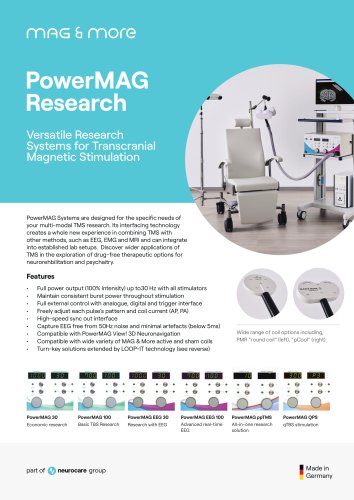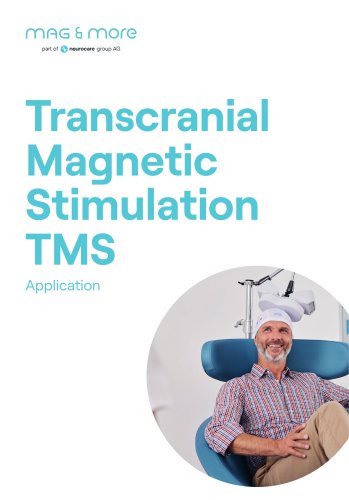 Website:
MAG & More GmbH
Website:
MAG & More GmbH
Group: Neurocare Group
Catalog excerpts

Optimized pulse length Numerous integration possible Decentral mini coils TMS Research Booklet Presenting TMS Applications & Solutions
Open the catalog to page 1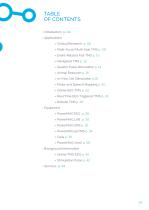
> Introduction p. 04 > Applications » Clinical Research p. 06 » Multi-Focal/Multi-Side TMS p. 08 » Event-Related Fast TMS p. 10 » Navigated TMS p. 12 » Quattro Pulse Stimulation p. 14 » Animal Research p. 16 » In-Vitro Cell Stimulation p.18 » Motor and Speech Mapping p. 20 » Online EEG-TMS p. 22 » Real Time EEG Triggered TMS p. 24 » Robotic TMS p. 26 > Equipment » PowerMAG EEG p. 28 » PowerMAG LAB p. 30 » PowerMAG QPS p. 32 » PowerMAG ppTMS p. 34 » Coils p. 36 » PowerMAG View! p. 38 > Background Information » Online TMS-EEG p. 40 » Stimulation Pulse p. 42 > Services p. 44
Open the catalog to page 3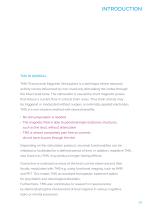
TMS in general TMS (Transcranial Magnetic Stimulation) is a technique where neuronal activity can be influenced by non-invasively stimulating the cortex through the intact skull bone. The stimulation is caused by short magnetic pulses that induce a current flow in cortical brain areas. Thus brain activity may be triggered or modulated without surgery or externally applied electrodes. TMS is a non-invasive method with several benefits: › No skin preparation is needed › The magnetic field is able to penetrate high resistance structures, such as the skull, without attenuation › TMS is almost...
Open the catalog to page 5
Clinical research Overview: Clinical TMS research is conducted to evaluate the safety and effectiveness of TMS by investigating its effects on human beings. Transcranial Magnetic Stimulation is a great way to selectively modulate (facilitating or inhibiting) targeted areas of the brain in order to treat neurological and psychiatric diseases. In contrast to pharmaceuticals, TMS is a non-systemic way of treatment, which means that TMS does not circulate in the blood stream throughout the body and does not have body wide systemic side effects. By delivering its therapeutic effects directly to...
Open the catalog to page 6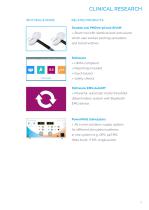
clinical research Why MAG & More: Related Products: Double coil PMD70-pCool-SHAM » Sham coil with identical look and sound, which also evokes pecking sensations and facial twitches Stimware » HIPAA compliant » Reporting included » touch based » safety checks Stimware EMG AutoMT » Powerful, automatic motor threshold determination system with Bluetooth EMG device PowerMAG stimulators » All in one solutions supply options for different stimulation patterns in one system (e.g. QPS, ppTMS, theta burst, rTMS, single pulse
Open the catalog to page 7
Multi-Focal / Multi-side tms Overview: Multi-side TMS describes the use of multiple, independently controlled stimulation coils which are all stimulating one subject. This form of TMS research is used for the investigation of functional connectivity within complex interconnected networks. By varying the timing and location of each coil, the temporal and spatial relationships between brain regions may be investigated. It is for instance possible to suppress one hemisphere while activating its counterpart. Another approach is to combine a “virtual lesion”, which is evoked by applying rTMS on...
Open the catalog to page 8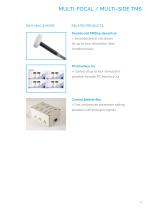
WHY MAG & MORE: RELATED PRODUCTS: Double coil PMD25-decentral » Small decentral coil allows for up to four stimulation sites simultaneously PC Interface X4 » Control of up to four stimulators possible through PC Interface X4 Control Splitter Box » Fast and precise parameter setting possible with analogue signals
Open the catalog to page 9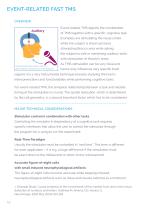
Event-related fast TMS Overview: Event-related TMS depicts the combination of TMS together with a specific, cognitive task. Examples are stimulating the visual cortex while the subject is shown pictures, stimulating Broca’s area while asking the subject to talk or combining auditory tasks with stimulation of Heschl’s areas. Theta Burst Stimulation 100 ms after speach detected on Microphone As TMS stimulation can be very focal and hence only influences very specific brain regions it is a very instrumental technique towards studying the brain’s interconnections and functionalities while...
Open the catalog to page 10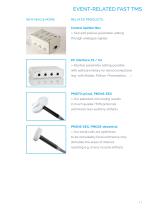
Event-related fast TMS Why MAG & More: Related Products: Control Splitter Box » Fast and precise parameter setting through analogue signals PC Interface X1 / X4 » Intuitive parameter setting possible with software library for serial connections (e.g. with Matlab, Python, Presentation, . . .) PMD70-pCool, PMD45-EEG » Our patented coil cooling results in much quieter rTMS protocols and hence less auditory artifacts PMD45-EEG, PMD25-decentral » Our small coils are optimized to be remarkably focal and hence only stimulate the areas of interest, resulting e.g. in less muscle artifacts
Open the catalog to page 11
Navigated TMS Overview: An individual and precise positioning of the TMS coil at selected brain regions can be crucial for TMS research. MRI-based neuronavigation systems can visualize the position of the stimulation coil in relation to a head in real-time at an individual, anatomical MR-data record. This enables the user to stimulate the target with great precision and makes reproducibility of the TMS set-up much easier. Additionally navigated TMS allows the researcher to protocol and map his or her work for studies and papers. Color coded fMRI data showing active regions of the brain is...
Open the catalog to page 12
Related Products: PowerMAG View! Neuronavigation » 6D targeting » Visualization of fMRI Data » Wizard guided, Intuitive system setup PowerMAG Coils » Integrated Navigation points (All Coils are prepared with neuronavigation points - coils from other companies can also be integrated) We are the only company to offer both stimulation AND neuronavigation solutions produced by the same manufacturer » All in one system solutions
Open the catalog to page 13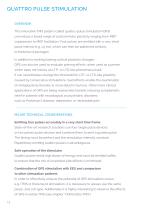
Quattro Pulse Stimulation Overview: This innovative TMS pattern called quattro-pulse stimulation (QPS) can induce a broad range of cortical motor plasticity ranging from MEP suppression to MEP facilitation. Four pulses are emitted with a very short pulse interval (e.g. 1.5 ms), which can then be patterned similarly to theta burst packages. In addition to evoking lasting cortical plasticity changes, QPS can also be used to evaluate priming effects: when used as a primer, which does not induce an LTP- or LTD-like phenomena itself, it can nevertheless change the threshold for LTP- or LTD-like...
Open the catalog to page 14All MAG & More GmbH catalogs and technical brochures
-
Product sheet View!
2 Pages
-
Product sheet PowerMAG
2 Pages
-
Product sheet Apollo
2 Pages
-
application
28 Pages
-
Effectiveness in Studies
32 Pages



